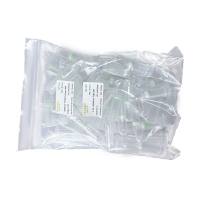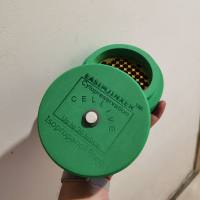Recombineering‐Based Procedure for Creating BAC Transgene Constructs for Animals and Cell Lines
互联网
- Abstract
- Table of Contents
- Materials
- Figures
- Literature Cited
Abstract
The use of BAC/P1 as a vector for the generation of a transgene has gained popularity after the genomic annotation of many organisms was completed (often based on the respective BAC library). Large?scale generation of BAC transgenic mice has proven that BAC transgene approaches have less integration position effects and dosage artifacts when compared with traditional transgenic approaches. Also, a BAC can achieve the same tissue?specific expression as a knock?in of the same gene with less effort and shorter time of establishment. The ??RED recombinogenic system has been used to manipulate DNA constructs with site?directed mutagenesis, truncation, and tagging with an epitope tag or as a fusion protein by homologous recombination, as well as used here to modify many BACs with various transgenes. The recombineering plasmid, pKD46, is used to fabricate BAC transgenic constructs that can be used in generating transgenic organisms as well as used in mammalian cell culture. Curr. Protoc. Mol. Biol. 95:23.14.1?23.14.28. © 2011 by John Wiley & Sons, Inc.
Keywords: BAC; recombineering; transgene
Table of Contents
- Introduction
- Basic Protocol 1: Fabrication of BAC Transgene Construct Through Recombineering
- Support Protocol 1: Purify Targeting Cassette with a Safeblue Gel
- Support Protocol 2: Prepare Electrocompetent Cells
- Support Protocol 3: Electroporation of a Plasmid into DH10B and its Derivatives
- Support Protocol 4: Storing and Handling Recombinogenic Bacteria Strains
- Support Protocol 5: Acquisition and Confirmation of BACs
- Support Protocol 6: Obtain BAC DNA for Transformation
- Alternate Protocol 1: Assemble a Targeting Cassette by PCR with Long Primers
- Alternate Protocol 2: Overlapping PCR
- Alternate Protocol 3: Arm Extension on the Targeting Cassette
- Alternate Protocol 4: Sequential Targeting for Transgene Swapping
- Alternate Protocol 5: Selection Marker Removal with Titration of Recombinase
- Commentary
- Literature Cited
- Figures
Materials
Basic Protocol 1: Fabrication of BAC Transgene Construct Through Recombineering
Materials
Support Protocol 1: Purify Targeting Cassette with a Safeblue Gel
Materials
Support Protocol 2: Prepare Electrocompetent Cells
Materials
Support Protocol 3: Electroporation of a Plasmid into DH10B and its Derivatives
Materials
Support Protocol 4: Storing and Handling Recombinogenic Bacteria Strains
Materials
Support Protocol 5: Acquisition and Confirmation of BACs
Materials
Support Protocol 6: Obtain BAC DNA for Transformation
Materials
Alternate Protocol 1: Assemble a Targeting Cassette by PCR with Long Primers
Materials
Alternate Protocol 2: Overlapping PCR
Materials
Alternate Protocol 3: Arm Extension on the Targeting Cassette
Materials
|
Figures
-

Figure 23.14.1 Insertion site of a transgene. The transcription start site is located at the beginning of the 5′UTR (untranslated region); all translated regions (coding sequence for protein‐CDS‐from start codon, ATG, to stop codon) are black. Inside the 3′UTR, the IRES‐CDS should be located before the poly‐A sites. View Image -

Figure 23.14.2 Flow chart of BAC targeting with targeting cassette. On the targeting cassette the left arm of homology (LAH) and right arm of homology (RAH) add a homologous region to the targeting cassette that matches the left and right flanking portion of the targeted site on the BAC. The genotyping primers (GT) must be located outside of the arms of homology. If the selection marker is flanked by FRT sites then use EL250 to remove the selection marker. If flanked by LoxP sites, use EL350. View Image
Videos
Literature Cited
| Copeland, N.G., Jenkins, N.A., and Court, D.L. 2001. Recombineering: A powerful new tool for mouse functional genomics. Nat. Rev. Genet. 2:769‐779. | |
| Datsenko, K.A. and Wanner, B.L. 2000. One‐step inactivation of chromosomal genes in Escherichia coli K‐12 using PCR products. Proc. Natl. Acad. Sci. U.S.A. 97:6640‐6645. | |
| Gong, S., Zheng, C., Doughty, M.L., Losos, K., Didkovsky, N., Schambra, U.B., Nowak, N.J., Joyner, A., Leblanc, G., Hatten, M.E., and Heintz, N. 2003. A gene expression atlas of the central nervous system based on bacterial artificial chromosomes. Nature 425:917‐925. | |
| Lee, E.C., Yu, D., Martinez de Velasco, J., Tessarollo, L., Swing, D.A., Court, D.L., Jenkins, N.A., and Copeland, N.G. 2001. A highly efficient Escherichia coli‐based chromosome engineering system adapted for recombinogenic targeting and subcloning of BAC DNA. Genomics 73:56‐65. | |
| Poser, I., Sarov, M., Hutchins, J.R., Hériché, J.K., Toyoda, Y., Pozniakovsky, A., Weigl, D., Nitzsche, A., Hegemann, B., Bird, A.W., Pelletier, L., Kittler, R., Hua, S., Naumann, R., Augsburg, M., Sykora, M.M., Hofemeister, H., Zhang, Y., Nasmyth, K., White, K.P., Dietzel, S., Mechtler, K., Durbin, R., Stewart, A.F., Peters, J.M., Buchholz, F., Hyman, A.A. and 2008. BAC TransgeneOmics: A high‐throughput method for exploration of protein function in mammals. Nat. Methods 5:409‐415. | |
| Wagner, M. and Koszinowski, U.H. 2004. Mutagenesis of viral BACs with linear PCR fragments (ET recombination). Methods Mol. Biol. 256:257‐268. | |
| Yang, X.W., Model, P., and Heintz, N. 1997. Homologous recombination based modification in Escherichia coli and germline transmission in transgenic mice of a bacterial artificial chromosome. Nat. Biotechnol. 15:859‐865. | |
| Zhang, Y., Buchholz, F., Muyrers, J.P., and Stewart, A.F. 1998. A new logic for DNA engineering using recombination in Escherichia coli. Nat. Genet. 20:123‐128. | |
| Internet Resources |









